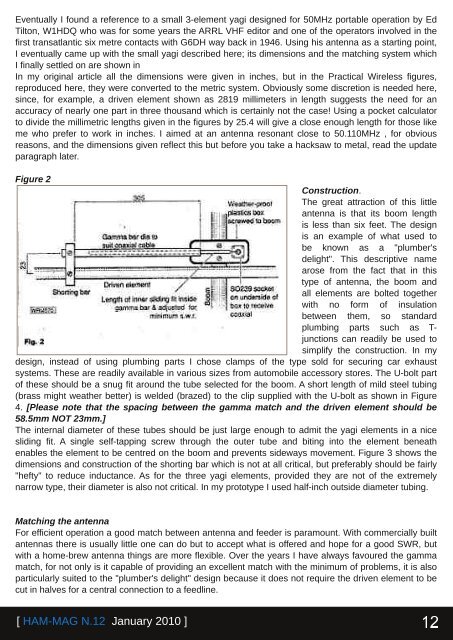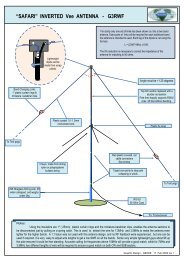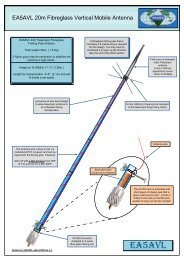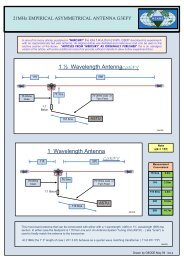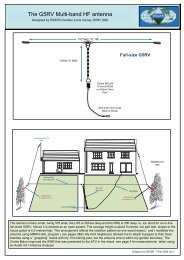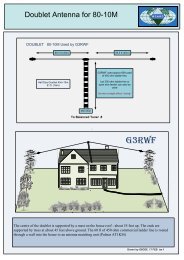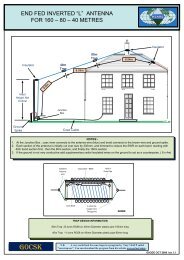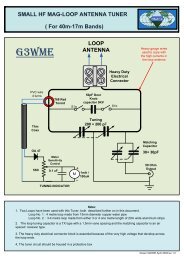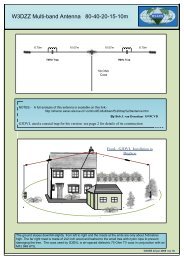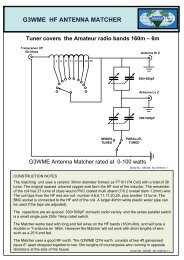A Small Yagi for 50 MHz - ONZ.be
A Small Yagi for 50 MHz - ONZ.be
A Small Yagi for 50 MHz - ONZ.be
- No tags were found...
Create successful ePaper yourself
Turn your PDF publications into a flip-book with our unique Google optimized e-Paper software.
Eventually I found a reference to a small 3element yagi designed <strong>for</strong> <strong>50</strong><strong>MHz</strong> portable operation by EdTilton, W1HDQ who was <strong>for</strong> some years the ARRL VHF editor and one of the operators involved in thefirst transatlantic six metre contacts with G6DH way back in 1946. Using his antenna as a starting point,I eventually came up with the small yagi descri<strong>be</strong>d here; its dimensions and the matching system whichI finally settled on are shown inIn my original article all the dimensions were given in inches, but in the Practical Wireless figures,reproduced here, they were converted to the metric system. Obviously some discretion is needed here,since, <strong>for</strong> example, a driven element shown as 2819 millimeters in length suggests the need <strong>for</strong> anaccuracy of nearly one part in three thousand which is certainly not the case! Using a pocket calculatorto divide the millimetric lengths given in the figures by 25.4 will give a close enough length <strong>for</strong> those likeme who prefer to work in inches. I aimed at an antenna resonant close to <strong>50</strong>.110<strong>MHz</strong> , <strong>for</strong> obviousreasons, and the dimensions given reflect this but <strong>be</strong><strong>for</strong>e you take a hacksaw to metal, read the updateparagraph later.Figure 2Construction.The great attraction of this littleantenna is that its boom lengthis less than six feet. The designis an example of what used to<strong>be</strong> known as a "plum<strong>be</strong>r'sdelight". This descriptive namearose from the fact that in thistype of antenna, the boom andall elements are bolted togetherwith no <strong>for</strong>m of insulation<strong>be</strong>tween them, so standardplumbing parts such as Tjunctions can readily <strong>be</strong> used tosimplify the construction. In mydesign, instead of using plumbing parts I chose clamps of the type sold <strong>for</strong> securing car exhaustsystems. These are readily available in various sizes from automobile accessory stores. The Ubolt partof these should <strong>be</strong> a snug fit around the tu<strong>be</strong> selected <strong>for</strong> the boom. A short length of mild steel tubing(brass might weather <strong>be</strong>tter) is welded (brazed) to the clip supplied with the Ubolt as shown in Figure4. [Please note that the spacing <strong>be</strong>tween the gamma match and the driven element should <strong>be</strong>58.5mm NOT 23mm.]The internal diameter of these tu<strong>be</strong>s should <strong>be</strong> just large enough to admit the yagi elements in a nicesliding fit. A single selftapping screw through the outer tu<strong>be</strong> and biting into the element <strong>be</strong>neathenables the element to <strong>be</strong> centred on the boom and prevents sideways movement. Figure 3 shows thedimensions and construction of the shorting bar which is not at all critical, but preferably should <strong>be</strong> fairly"hefty" to reduce inductance. As <strong>for</strong> the three yagi elements, provided they are not of the extremelynarrow type, their diameter is also not critical. In my prototype I used halfinch outside diameter tubing.Matching the antennaFor efficient operation a good match <strong>be</strong>tween antenna and feeder is paramount. With commercially builtantennas there is usually little one can do but to accept what is offered and hope <strong>for</strong> a good SWR, butwith a homebrew antenna things are more flexible. Over the years I have always favoured the gammamatch, <strong>for</strong> not only is it capable of providing an excellent match with the minimum of problems, it is alsoparticularly suited to the "plum<strong>be</strong>r's delight" design <strong>be</strong>cause it does not require the driven element to <strong>be</strong>cut in halves <strong>for</strong> a central connection to a feedline.[ HAMMAG N.12 January 2010 ]


